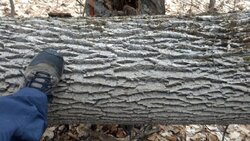Had some mighty vicious wind here last week (gusts near 70 recorded) and there's a decent amount of downed trees near me. The state lets you scrounge downed wood on state land for $50 and I'm thinking of doing this next summer after finding a good amount of maple, beech, ash, and cherry near my house. Also found the tree seen below. I think it's a maple, but the bark is different than the other maples I've been processing. Is it maple?
Also, a thought... A sticky with the most common trees (pics of leaves and bark at different tree ages) sorted by climate zone might b&b used by a lot of people. Even better... Is there a link to an interactive page for tree species classification?
Also, a thought... A sticky with the most common trees (pics of leaves and bark at different tree ages) sorted by climate zone might b&b used by a lot of people. Even better... Is there a link to an interactive page for tree species classification?


